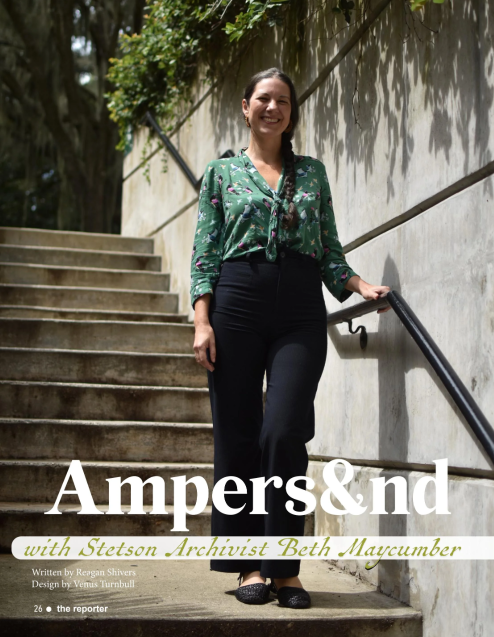I sat down with Stetson University Archivist Beth Maycumber to welcome her to her first year at Stetson and delve into the archives’ role in celebrating Stetson’s 140th anniversary.
Q: What was your path to becoming an archivist?
A: I was a History major for my undergraduate and also for my first graduate degree. But originally, I thought that I was going to teach history. And then I took an internship kind of on a whim with the National Park Service. And as a museum technician, I learned about collections care and objects care. And I really love that. And that turned into a job for a little bit. But then I, just because of life circumstances, or what have you, I ended up working in a public library for 10 years. And I went back to school to USF and got a second master’s in library and information science. But I focus on archives. And so now I’m here. But I took as many courses as I could, on archives, and then in all my other general classes, I based all of my coursework scenarios on archives.
Q: How has your experience with this new position been shaped by Stetson’s 140th anniversary?
A: It’s really fantastic for me, because I’m learning so much. I’m on The 140, a planning committee. And we’re focusing on one decade per week, all semester. And so for me, what I’m doing is I’m creating Facebook posts each week. And so it’s a big deep dive into what are the important things that happened in that decade. What are the buildings that were erected in that decade, who really important people are, so it’s a really great, deep dive for me sort of about the collection.
Q: So would you say that the anniversary is helping you get to know the school?
A: Absolutely. Every research request, or anything that I do helps me learn about the school. But this is a very specific timeline of, you know, every single important event. I’m trying to figure out what those events were and what we have in the archives that reflect that. So it’s a really fantastic experience for me.
Q: What does a typical day in the office look like?
A: There is no such thing as a typical day in the archives. There is a lot of work to be done. There’s a lot of different projects, but at the same time, I have student workers who I have to prep and kind of supervise the work that they’re doing. There’s research requests that come in all the time from people on campus, and from people off campus. And a lot of those things people will just walk in. So it’s hard to say that there’s a typical day, but some of the things that I would do. . . on any given day randomly, I might be giving a tour of the archives and showing off specific items that we have in our collection. I will be going through our backlog and trying to process things and accession things to add them to our collection, digitize things to have in the digital archives, rehousing things . . . preservation is very important in an archive. So trying to make our paper and digital objects last as long as they can. There’s many, many different things that I do in a day. It’s fun.
Q: How would you suggest students use the archives outside of class work?
A: I think that a really good thing for students to do is come to the archives, and tour, just to get a sense of what we have in the collection and also just look online at the digital collections because you can see a lot that we have in the digital collections just to get a sense because it might inspire you to do your own research. Or if later when you’re doing a research project . . . if you know what we have that might spur interesting questions . . . there’s all kinds of information in the archives that’s just waiting for someone to find it.
Q: What’s your favorite, or most surprising item you’ve found in the archives?
A: I love everything. And I would say that there’s always one special thing at least every week that I find, but I can’t say that I have a favorite thing. But for instance, the Stetson hat collection, that’s actually part of the memorabilia collection right now, and I do want to actually take that out and make it its own collection so that it’s more accessible, so that people would know that we have it. But there’s these little tiny hats . . . when you bought a Stetson hat, it’s fitted to your head. And so if you wanted to buy a hat for somebody else, you would go into a store, and you would purchase this little tiny hat. And then the person who was given the hat could go into any Stetson retailer. And it’s not that you would get that hat. But that hat was a price range. And so you could pick a hat from that price range. We have all these wonderful Stetson hats, but we also have all these little tiny Stetson hats. It’s like a hard but a very cute gift card.










